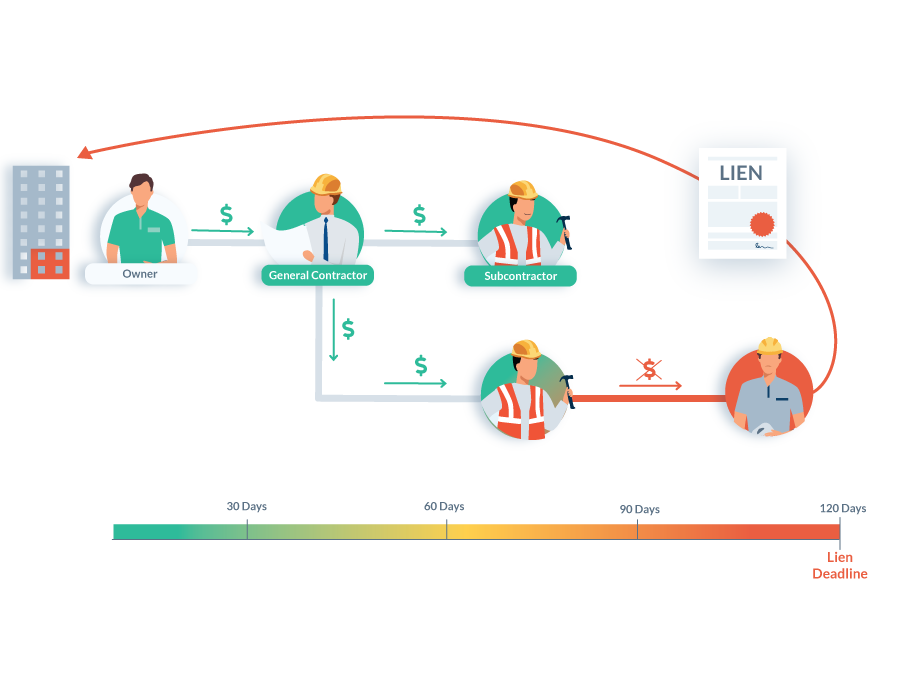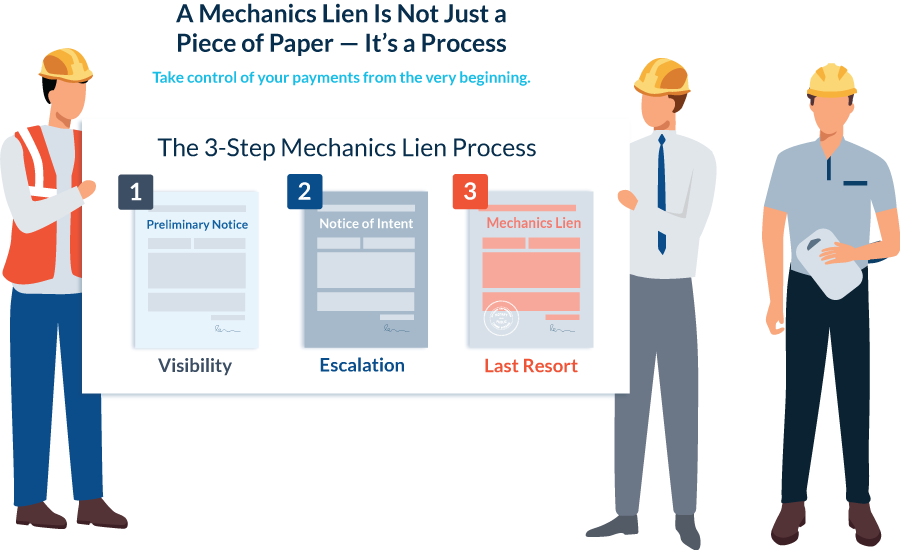
It seems like an easy question, but alas, a mechanics lien is one of the most confusing legal instruments in the United States. Not only do mechanics liens confuse the hard-working folks in the construction industry, but they’re also quite a challenge for many licensed attorneys! In this article, we break down the legal definition of a mechanics lien and explain how each part works in construction.
Read more: Learn the mechanics lien laws in every state
What Is a Mechanics Lien?
A mechanics lien is an involuntary security interest granted by law to construction participants to secure payment for labor or materials furnished to improve property. (Hence, why it’s sometimes known as a construction lien.)
Sound a little too lawyerly? We thought so too. Let’s break the mechanics lien definition down further, phrase by phrase…
What does ‘involuntary security interest’ mean?
You’re probably already familiar with security interests. Perhaps the most common example is a mortgage on a house. When you get a home loan from your lender, that lender will require a security interest (mortgage) on the house until you pay off the debt. And we all know what happens when you don’t pay — the lender can foreclose and force a sale of the property to satisfy your debt.
But a home mortgage is an example of a voluntary security interest. You went to the lender and agreed to take a loan out on your house, and the lender agreed to lend with the house as collateral. And you signed (probably tons of) paperwork stating as much.
That’s a little different from an involuntary security interest. A mechanics lien exists without the property owner agreeing to it. There are loads of requirements that must be met in order to file a valid mechanics lien, but getting the owner’s permission is not one of them.
What does ‘construction participants’ mean?
To qualify for a mechanics lien right, generally, you must perform construction work. In other words, a doctor can’t file a mechanics lien against one of their patients that didn’t pay their bill. Mechanics liens are special rights reserved for the construction industry.
What does ‘secure payment’ mean?
A mechanics lien secures payment by using the property itself as the collateral for the debt. If the debt isn’t paid, your security interest in the property allows you to force a foreclosure to recover the funds. That’s the security – the right to payment is tied to the property.

What does ‘labor or materials furnished’ mean?
This one is pretty easy. In order to qualify for a mechanics lien, you must provide something of value — labor and/or materials — to a construction project. So, the food truck operator that swings by the job site can’t file a mechanics lien if he gets stiffed the money he’s owed for lunch.
What does ‘improve property’ mean?
This part can be tricky. For lien rights to arise, the labor or materials supplied must go towards improving a piece of real property. For material suppliers, the supplies they sell to a construction project generally must be incorporated into the property on the project in order for a lien right to be present.
Why Are Mechanics Liens Necessary?
Because of the complexity of the payment chain on a construction project, getting paid is hard. A mechanics lien empowers contractors, suppliers, and others that work in the construction industry to get paid the money they’ve earned on their projects and jobs.
And that’s really it.
A mechanics lien is a legal right that is available to some extent in all 50 states. Generally, direct contractors, subcontractors, material suppliers, equipment lessors, design professionals (architects and engineers), and laborers all possess lien rights.
Mechanics liens are only available to the American construction industry, and have been around since the 1790s! In fact, Founding Father Thomas Jefferson is credited with first bringing the mechanics lien concept to the United States. The remedy is unique to common law countries, like the US and England, but the rest of the world doesn’t really have this.
Mechanics liens are a very powerful remedy that is in contrast to the usual workings of the law. Attorneys and contractors alike call mechanics liens the most powerful tool available to contractors and suppliers to make sure that they get paid the money that they’ve earned on their construction projects and jobs.
Though the mechanics lien rules are different in every state, a lien can be filed on most any private construction project, whether the project is residential (on the house itself) or a commercial project.
A Mechanics Lien Is Not Just a Piece of Paper — It’s a Process
Construction companies should think of lien rights management as a process, and not as a stand-alone document.
In fact, filing a lien is not the first step at all. It’s actually the third step in the process, and in order to protect the ability to file a mechanics lien, one must send specific notices, fulfill specific requirements, and meet specific deadlines ahead of time, often long before a mechanics lien enters the picture.
Read more: How to file a mechanics lien
The 3-Step Mechanics Lien Process
There are three steps that make up the mechanics lien process. Download our simple guide to the process so you can easily stay on top of your lien rights on every job.
- Step 1: Preliminary Notice
- Step 2: Notice of Intent
- Step 3: Mechanics Lien
This three-step method is all about proactively managing your payments on all of your jobs. Instead of just waiting for a payment problem to happen, the best practice is to take control of your payments from the very beginning. If you want to get help managing payments proactively on all your jobs, we can help.

Liens Attach to the Property, not to a Person or a Company
Another important aspect of mechanics liens is that a valid lien attaches to the piece of property that’s being improved in the construction project. When you file a mechanics lien, the document is actually recorded with land records and appears on a title search of the property. Anyone who buys or accepts the property after the recording of your lien claim (and sometimes, in some states even before the recording), accepts it subject to the claim. As a practical measure, this means the property will not be sold, refinanced or otherwise transferred without the mechanics lien claim being paid or addressed.
This is somewhat counterintuitive because in many cases where a mechanics lien is filed, it’s not the property owner that owes the debt to the lien claimant. On a hypothetical construction project, let’s assume that the property owner pays the general contractor, and the GC pays the subcontractor, but then the subcontractor does not put the sub-subcontractor. If that sub-sub has a lien right and decides to file a mechanics lien, the lien is filed against the property owned by the property owner, even though the debt is owed by the subcontractor.
A Few Things to Keep in Mind
Here are some general notes to keep in mind when trying to understand construction or mechanics liens:
- Liens attach to the property, not to a person or a company
- In general, those who perform labor or supply materials on a construction project will have the right to lien the project
- The method of filing a construction lien varies state-by-state
- In the majority of states, sending a preliminary notice is a required step in order to preserve your mechanics lien rights
- Your lien must be filed within a defined timeframe
- Once filed, a lien will expire, and in some states, they expire very quickly
- If filing your lien does not produce payment, you will need to “perfect” or foreclose on your lien within a defined time period
More Mechanics Lien Resources
- Mechanics Lien information for All 50 States (free lien and notice forms, state-by-state FAQs, and much more)
- Levelset Community (ask a legal question and get a free answer from a licensed attorney)
- File a Lien in Minutes with Levelset


